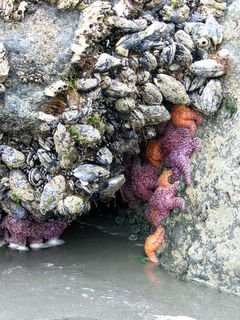We took our time getting moving...we barely made it to the front desk before check out at 11:00 AM.
After a quick breakfast at the lodge we back tracked a few miles up the 101, to Ruby Beach. The weather was perfect, sunny and warm, yet again. We'd seen scarcely a cloud since Shelton, and I began to feel a tiny bit cheated. Who spends six days on the Olympic Peninsula without getting soaked a couple times?
Ruby Beach was so named for the bright red gemstones found there by early explorers of the Olympic Coast. These stones weren't really rubies at all, though, but garnets worth only a fraction of what true rubies would have fetched.
We didn't find any garnets, but, we did find some pretty cool tide pools. Large colonies of orange and purple sea stars decorated the rocks near the water, while neon pink and green anemones populated the spots in between.


While these anenomes look high and dry, they were in fact several inches underwater. We couldn't believe how clear these little pools were.

A friend told me these little pink things pack a wallop. Call me a coward, but, I never tested them. They looked a little too toxic to muck with.
We took a few pics as we scrambled over the rocks at low tide.



Good times.
We finally left Ruby beach to indulge my nerdy fascination with big trees. The first stop on this tour-de-wood was the famous (who am I kidding...only a handful of tree geeks even know this thing exists) Duncan Cedar. It was thought be the largest Red Cedar in the world for much of the 1970's and 80's, but two larger trees were discovered in the 1990's, dethroning this former champion.

A tiny crown of living branches and leaves are all that suggest this monumental old cedar is even alive. This tree is perhaps a thousand years old, but it might not live out the decade.
Next, we visited another big Red Cedar, just off the 101 near the Kalaloch beaches. I expected the Kalaloch tree to be a bit of a let down, having just seen the mighty Duncan Cedar. I was wrong. It was was crazy. The single oldest looking thing I've ever seen. It was massive, knobby and sinuous, with misshapen faces popping out through its ancient bark. The wildest looking caricature of a Western Red Cedar imaginable.

Shauna and the Kalaloch Cedar...


I couldn't decide wether this was a root or a branch.
After ogling the Kalaloch Cedar for a few more minutes we made our way South, along the 101, towards Lake Quinault. The Lake Quinault area is arguably the finest remaining patch of temperate rainforest in the continental United States.

I tend to think it is...

A car in front of us lends a little scale to some of the Red Cedars we saw while driving along the north shore of Lake Quinault. Six of the ten largest known Red Cedars in the world are found somewhere on the wooded slopes near Lake Quinault. We didn't have time to visit them all, but, we did get to see the biggest of them. The single largest tree in the Pacific Northwest, and perhaps the entire world outside of the state of California (it's no fair comparing anything to the Coast Redwoods and Giant Sequoias).
The Quinault Cedar.


Shauna inside the world's Biggest Cedar...I'm sure you're all wetting yourself with excitement.
We left the Quinault area, and ultimately the Olympic Peninsula after completing the loop around the lake. We'd spent far more time on the peninsula than we had planned, and we were hopelessly behind schedule. That said, we'll never regret a single moment we spent there. Though I expected to see some cool things in the days remaining, I had a feeling the best might be behind us.
1 comment:
wow!!! what an awesome tree!
Post a Comment